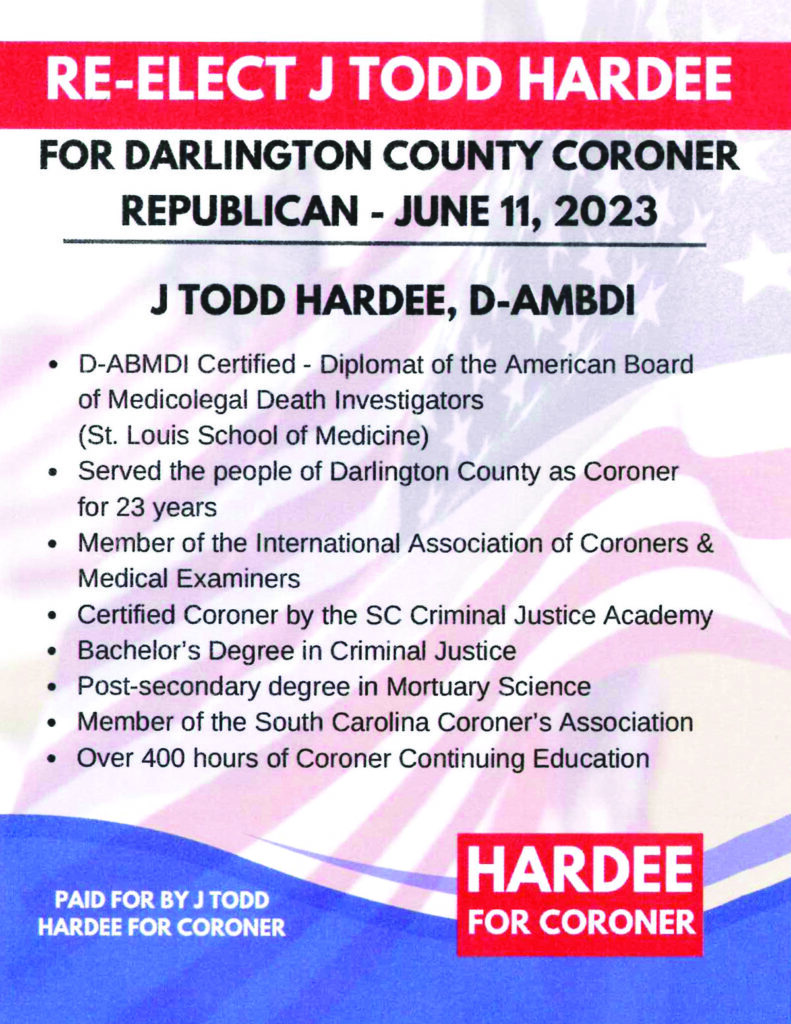The tragic history of the Pee Dee Community Center

By Max Everhart, Special to the News and Press
In the movie Field of Dreams, an Iowa farmer named Ray Kinsella (played by Kevin Costner) hears a disembodied voice whisper, “If you build it, they will come.” Although considered a crank, Ray builds a baseball diamond in his cornfield, and, magically, long-dead ballplayers from the disgraced 1919 Chicago White Sox begin showing up to play America’s Pastime.
I have to wonder if Keith Lockwood, a native of Charleston who married a Darlington girl, heard similar voices when in 1925 he first set foot on 30 acres of prime real estate near High Heel, just a stone’s throw from the newly paved road known as the Darlington-Florence Highway. At the time, the country’s economy was booming. Automobiles were becoming more popular—and more affordable—and Lockwood must have sensed that if he built something grand, the people would come.
So in July 1925, Lockwood announced his plans to develop a resort/playground complex, which he dubbed the Pee Dee Community Center. To be built upon what is now part of Florence Darlington Technical College’s main campus, this grand complex would include a Dance Hall, Convention Center, restaurant, bowling alley, beauty shop, picnic areas, camp sites for Boy Scouts, a Ferris wheel, and a large swimming pool.
Soon after, Lockwood organized a stock company under the wonderfully exotic name Les Heures de Joie, Inc., and in November 1925, the company was granted its charter by the state of South Carolina. The initial capital stock totaled some $50,000, which would be roughly $350,000 in today’s money. Among the original stock holders from Darlington were C.E. Gardner, a public accountant; Earle R. Baxter, publisher of the News and Press; and Edwin W. Fountain, mayor of Darlington. Dr. Frank H. McLeod, a physician and surgeon who founded McLeod Hospital, was also a stock holder, along with other prominent Florence natives J.B. Long and Munford G. Scott.
Despite keen interest from the public, it would be almost eighteen months before the Pee Dee Community Center, known locally as Happy Hours, would open. When it did open for a New Year’s Eve Dance on December 31, 1926, the facility wasn’t yet complete. Although the original plans had been scaled back, Happy Hours “informal opening” was such a success that it was quickly followed by other events. Perhaps the most memorable was a masquerade dance held on Valentine’s Day. According to an article in the News and Press, “six hundred and eighty-two admission tickets were sold,” and “joys and pleasures reigned supreme.” But what captured the reporter’s imagination was the dance hall’s lighting system, described as such: “This is the large shell-like glass reflector on the platform for the musicians. This is made entirely of glass curved like a huge conch shell with 200 electric lights. Various colors are flashed at intervals through these globes, making successive waves of light, floating silently, but most effectively over the scene.”
In the summer of 1927, the 400’ X 200’ swimming pool at Happy Hours officially opened. An advertisement dated July 1927 claimed the swimming pool had an “artesian flow of 1,000,000 gallons every 24 hours,” while another ad encouraged patrons to bring jugs to fill up because the water contained “iron and sulfur,” and “just a jug a day, keeps the doctor away.” The swimming pool was such a major attraction that the Hayes Bus Line offered special group rates to reach Happy Hours.
But the swimming pool wasn’t the only big draw that fateful summer. Dancing, too, brought in huge crowds. In the early days, the Florence Serenaders and the Carolina Buccaneers provided the music, much to the delight of the young folks ready to dance. Later, more famous acts like Hal Kemp, Jan Garber, and Kay Kyzer would play.
And so, for one glorious summer in 1927, the Roaring Twenties managed to make it all the way to the Pee Dee. For one glorious summer, Happy Hours lived up to its name, kids swimming by day and dancing at night.
Until tragedy struck.
In mid-July 1927, a man named W.W. Register broke his neck while diving “headlong into shallow water at Happy Hours swimming pool.” Although he clung to life for a few weeks, Register died, and his story was widely reported in the Florence Morning News, casting a dark cloud over Happy Hours.
Not long after, creditors began demanding payment, and, ultimately, Keith Lockwood had to file for bankruptcy. In February 1928, Mrs. Sanborn Chase, who held the mortgage on the Happy Hours property, filed foreclosure proceedings, and in March, the property was seized by the Sheriff and sold on the courthouse steps. Mrs. Chase did reopen Happy Hours, tapping her brother Clyde Glenn to run the day to day operations. The resort remained open through 1928 and into the summer of 1929.
Still, whether Keith Lockwood or Mrs. Chase knew it or not, poor W.W. Register was foreshadowing personified. For in 1929, the stock market crashed, plunging the country into the Great Depression. Like many businesses of the era, Happy Hours never recovered from the aftershock of Black Tuesday. Mrs. Chase sold the property in March 1930, and the rest of the buildings were either burned or torn down.
Today, all that remains of Happy Hours is the concrete wall of the swimming pool, which is on the main campus at FDTC. In a week or so, I will start teaching English classes there, and my first order of business to go sit near that concrete wall. Maybe, if I listen hard enough, I might hear the sounds of children splashing water and squealing with delight. Or maybe, like Ray Kinsella, I might hear a disembodied voice telling me to build something grand, something that would make people happy, if only for a few short hours.


